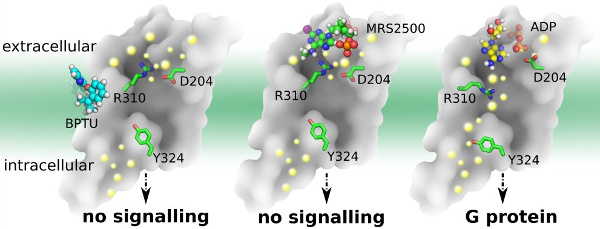博文
The Molecular Mechanism of P2Y1 Receptor Activation
|
S Yuan*, H.C. S. Chan, H Vogel, S Filipek, R. C. Stevens* and K. Palczewski*
Angew. Chem. Int. Ed. (2016) 10.1002/ange.201605147, First published: 27 July 2016
Abstract
Human purinergic G protein-coupled receptor P2Y1 (P2Y1R) is activated by adenosine 5'-diphosphate (ADP) to induce platelet activation and thereby serves as an important antithrombotic drug target. Crystal structures of P2Y1R revealed that one ligand (MRS2500) binds to the extracellular vestibule of this GPCR, whereas another (BPTU) occupies the surface between transmembrane (TM) helices TM2 and TM3. We introduced a total of 20 μs all-atom long-timescale molecular dynamic (MD) simulations to inquire why two molecules in completely different locations both serve as antagonists while ADP activates the receptor. Our results indicate that BPTU acts as an antagonist by stabilizing extracellular helix bundles leading to an increase of the lipid order, whereas MRS2500 blocks signaling by occupying the ligand binding site. Both antagonists stabilize an ionic lock within the receptor. However, binding of ADP breaks this ionic lock, forming a continuous water channel that leads to P2Y1R activation.
Figure legend: Molecular mechanism of action inferred from the P2Y1R structure. Left panel: Antagonist molecule BPTU binds to P2Y1R and stablizes the ionic lock between K461.46 and R195ECL2 via a decrease in the lipid order. No continuous internal water channel is formed. Middle panel: Antagonist molecule MRS2500 binds to P2Y1R and stablizes the ionic lock between K461.46 and R195ECL2. No water continuous internal water channel is formed. Right panel: Agonist molecule ADP binds to P2Y1R and disrupts the ionic lock between K461.46 and R195ECL2. Y3247.53 undergoes a molecular switch that results in the formation of a continuous water channel inside the receptor.
https://blog.sciencenet.cn/blog-355217-993303.html
上一篇:World Life Science Conference 2016 in Beijing
下一篇:Basel Life Science Week (Sep. 19-23, 2016)
